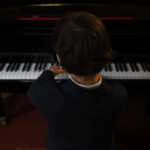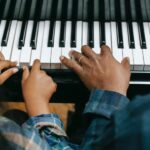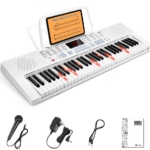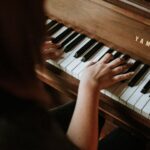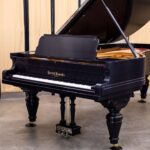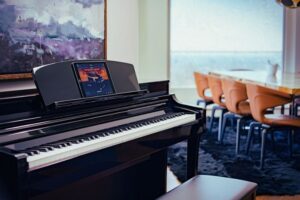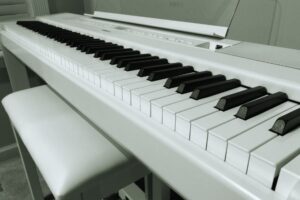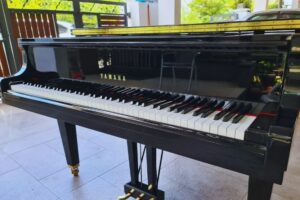Learning how to play the piano is a very fulfilling and fun challenge to take on. But like all instruments, there is a right way and wrong way to learn the piano. What is the best way to learn piano on your own?
The best way to learn piano is as follows:
- Familiarize yourself with the piano
- Learn the keys
- Learn the chords
- Learn proper fingering
- Learn the proper posture
- Make use of online teaching sources
- Follow a regular practice schedule
- Don’t try to do everything at once
- Warm-up before practicing
- Take note of the patterns
- Practice music that you enjoy
- Learn to read music
If you don’t have a piano, you should get a good digital keyboard that you will enjoy playing. The keys on a digital keyboard are lighter than a real acoustic piano. This makes it easier for beginners to learn. You can easily transfer the skills you learn from the digital keyboard to an acoustic piano.
When looking for a digital piano, it is best to get a keyboard with the full 88 keys. Also, you should get a proper adjustable seat and dampening pedal.
The Alesis Virtue 88-Key Beginner Digital Piano is an excellent bundle pack for learning to play the piano by yourself. It has everything you need to learn and grow into a better piano player for a great price.
Click here to see it on Amazon.
Read on to learn more about the best way to learn piano and how you can learn it faster.
Best Way to Learn Piano
The best way to learn piano on your own is to first learn the basic keys, chords, and fingering. Follow consistent practice sessions, play songs that you enjoy, and use online resources. Eventually, learn how to read music.
You are fortunate because nowadays, you don’t need a personal teacher to learn the piano. Moreover, if you don’t have access to a real piano, you can buy an affordable keyboard with full 88 keys, and you will have a ‘piano’ that you can use as a good substitute.
If you can’t get to a real piano, buy a keyboard with a touch sensitivity feature. This feature will enable you to produce the sound dynamics that real pianos can produce. Think about the softness and loudness of sounds.
This is sound dynamics. It is the one that makes piano music and any music for that matter, alive and vibrant, not cold and mechanical. If you want to learn the piano, you should also learn how to create music that’s not mechanical but lyrical and able to move the human spirit.
The Alesis Virtue 88-Key Beginner Digital Piano is semi-weighted, which means you can control the volume based on how hard or soft you press the keys; however, the keys aren’t fully weighted like a real acoustic piano.
Click here to see it on Amazon.
You don’t need a fully weighted piano when starting out; however, if you pay a bit more, you can get fully weighted keys that mimic an acoustic piano. A great digital keyboard with fully-weighted keys is the Yamaha P45, 88-Key Weighted Action Digital Piano.
Click here to see it on Amazon.
What is the best way to learn piano? The best way to learn to play piano is by following the below 12 tips. If you follow all these tips, you will learn piano in a shorter period of time.
1. Familiarize Yourself with the Piano
The first step before you can learn to play the piano is to familiarize yourself with this instrument. For sure, this is not your first time seeing a piano. You must have noticed that it is composed of white keys that are interspersed with black keys. There are also a set of pedals underneath it.
Take note of the location of middle C. This will be your home base in learning the piano. It is a white key located near the middle of the keyboard. The keyboard is the whole set of 88 keys on the piano.
2. Learn the Keys
Next, study the basic keys. White keys are called naturals, and black keys are called accidentals. The naturals are the keys of C- D -E- F- G -A- B, and the accidentals are the flats or sharps of the natural keys. Every octave has five accidentals. They are either flat or sharp.
Here is a video that shows these keys on the piano.
In learning the piano by yourself, you should first learn the major keys. You could learn this by using a numbering system. The major keys in the piano are C, D, E, F, G, A, B, and C. For example, you can designate 1 as the middle C, 2 as D, 3 as E, 4 as F, 5 as G, 6 as A, 7 as B, and 8 as C.
You can play the intro of “Mary Had a Little Lamb” using the numbers system by hitting the keys in this way: 3-2-1-2-3-3-3. As you can see, there are only 8 major keys that you should worry about. The C’s on both sides are of the same pitch, but one is the other’s octave.
3. Learn the Chords
The best way to learn to play the piano fast is to learn the most common piano chords. You don’t have to learn all piano chords right away; just learn the common ones.
Piano chords are either major or minor. Major chords use the root key, the third, and the fifth keys. Minor chords use the root key, flat third key, and fifth key.
You can find the major and minor keys on the piano by doing an online search. The internet provides you with the easiest way to learn piano on your own, so take advantage of it. You’ll be surprised that there are plenty of online resources that you can choose from.

4. Learn Proper Fingering
Distinguishing a self-educated pianist from a formally educated pianist is somewhat easy. Just look at their fingers when they play, and you will see. So, if you want to pass off as a formally educated pianist, pay attention to your piano fingering style.
It would be best to learn where your fingers are supposed to go with whatever piano chords you are making. The best way to do this is to learn how to play the piano scales. Begin learning the major keys and when you have mastered that, go on to the minor keys.
It will help if you will number your fingers from 1 to 5, starting with your thumb on both hands. 1 is your thumb, 2 is your pointy, 3 is your middle, 4 is your ring, and 5 is your pinky. That goes on both hands. Your right hand will play the scale 1-2-3-1-2-3-4-5, and your left hand will do 5-4-3-2-1-3-2-1.
The right way to do it is to cross your thumb under your third finger in playing the second 1 as your fingers go up the scale. In coming back down the scale, be sure to cross your thumb with your third finger at the second 3.
Do this first on your right hand and when you have mastered it, go on to your left hand. Don’t rush it because you are just starting to create synapses in your brain for this activity. Once you are already comfortable and secure, that’s when you can do the scales on both hands.
Practicing the scales will go a long way in passing yourself off as a formally educated pianist.
5. Learn the Proper Posture
There’s a reason why you should have the proper posture when playing the piano. It’s not only to make you look good and proper; it is also for health reasons. Practicing piano for long hours will strain your back muscles if your posture is not right.
While playing the piano, you will repeatedly make the same motions with your fingers, hands, wrists, arms, and shoulders. Having a good posture is the key to avoiding undue strain and stress on these parts of your body.

6. Make Use of Online Teaching Sources
You can take advantage of online teaching resources. Making use of these resources is the best way to learn piano online. You can learn the piano at home without attending a physical class conducted by a real-life teacher.
There are also interactive apps that you can use. They are the next best thing to a live piano teacher because you can see and imitate what they do. The only drawback is that you won’t get their feedback since most of these videos are pre-recorded.
But still, they are good teaching resources that will help you learn the piano easier and faster.
7. Follow a Regular Practice Schedule
Learning the basics and the skills will go to nothing if you don’t practice them. The practice is the way your brain cement new knowledge that you have acquired.
According to Malcolm Gladwell, experts of something could only be that way if they spend 10,000 hours practicing what they are good at.
If you want to really learn the piano fast, set your practice schedule, and be strict in observing that schedule. Having a schedule is the best way to learn the piano on your own. As a beginner, shorter practice sessions will give better results.
But as you progress, you need to spend at least 30 minutes each day to hone your skills. Concert pianists have to spend at least 4 hours of practice each day to play the piano exceptionally well.
8. Don’t Try to Do Everything at Once
It is a mistake to try to learn everything in piano playing in a short time. Some of the skills and techniques may not be feasible for you at this stage. You will only squander your time and effort if you try to do everything at once.
Focus on learning a set of skills that, once you can master, will make everything easier for you to learn. Use this approach in selecting the music you want to play. Chances are, they would only need a certain skills subset for you to play them reasonably well.
You can apply Pareto’s rule in your piano learning objective. The idea is: 80% of your progress should come from 20% of your efforts. You only need to learn the skills that will help you play the music you want reasonably well.
Again, the best way to learn piano is by mastering the basics first. You may also opt to utilize online learning resources to make learning easier. And, of course, practice regularly.
Learning the piano using a keyboard with 88 keys is also easier for most people. This is because its keys are lighter. Then, once you have grasped how to play a keyboard, you can practice on a piano.
9. Warm-up Before Practicing
The best way to learn piano at home is to incorporate warm-up exercises in your session. You are required to do some warm-up exercises before doing your heavy workouts. It’s the same with the piano playing. You have to warm up your fingers before plunging into your piano lessons.
The muscles on your hands, wrists, and fingers need to be relaxed and ready for action before you put them into action. It is necessary to do some stretching of your hands and do some warm-up exercises for your fingers.
This will help facilitate blood flow and release the stiffness on your hands and fingers.
10. Take Note of the Patterns

As you progress in your piano lessons, you will inevitably see the piano patterns that are commonly used. Take pains to learn these patterns and progressions because if you are aware of them, it will speed up your learning.
The intent is to use these patterns to easily learn to play the music or songs you want to play. Rather than just learning the individual notes, you can see the notes as a harmonious group that shows up most of the time. Music patterns will also show you how music melodies are created.
11. Practice Music That You Enjoy
You want to learn the piano because you think you will enjoy it. To be able to really enjoy piano playing, don’t just practice the rudiments. Take your favorite song or piano piece, and start practicing it as soon as you can. Start with your favorite pop song that is at your level of learning.
Once you can play it, you will be encouraged to try other songs. In a few weeks, you will find yourself playing a simple jazz piece.
12. Learn to Read Music
Lastly, you can never pass off as an exemplary pianist if you don’t know how to read music. But this should be more of a long-term objective. You should only learn how to read music once you have developed the rudimentary skills to play decent piano music.
You have reached this far, so it won’t be hard for you to reach for some more. More avenues will open up to you if you know how to read music.
Conclusion: Best Way to Learn to Play Piano
The best way to learn piano on your own is by following these steps:
- Familiarize yourself with the piano
- Learn the keys
- Learn the chords
- Learn proper fingering
- Learn the proper posture
- Make use of online teaching sources
- Follow a regular practice schedule
- Don’t try to do everything at once
- Warm-up before practicing
- Take note of the patterns
- Practice music that you enjoy
- Learn to read music
Now that you know the best way to learn piano, you can now go ahead and begin learning.
Focus on the basics first. Then, practice and learn how to read music. It would be best if you utilize online learning resources and play the music you enjoy.
Related reading:
How Hard Is It to Learn Piano?
Is Piano Easy to Learn? Plus How to Learn Fast






